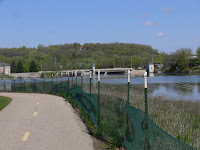 Visiting Art & Sharon
Visiting Art & SharonWhen I've vacationed in other countries such as Sweden, Cuba or Spain, I've had an expectation that things will be different. Immersion is impossible for me in those countries since I do not speak those languages, and as a consequence I am not aware of local issues and problems that form the foundation of what is important to the the people there. For example, I tried but unsuccessfully to get an English newspaper in Cuba. Perhaps this fact, more than any other, is what gives Americans such a bad reputation when traveling outside our own country.
In Canada, I do speak the language (at least in Alberta) so I am up on the news. We watch local TV stations, read the local newspaper. In addition, conversations with our friends and their interactions with their friends and families gives us an intimate sense of what's going on here and what's important to them.
We've had enough conversations with our Canadian friends during winters in the US to get a sense of their view of the world. Even so, living in their neighborhood, watching them demonstrate their commitment to their town, province, and country presents a fuller spectrum of Canada and its people when compared to our life in the US.
For example, the folks we've met here are impacted by the recession much as we are. Their retirement funds have been reduced by the stock market decline. Canada has many of the same industries as the US, though often with different names. Shopping centers look very similar, and the inside of a Walmart is just like in the US. But other different stores compete with Walmart, places like Canadian Tire. Learning the names of common Canadian stores helps us know where to find things, and having done that, we think we can fit right in.
But we often bump into the differences and realize that we're still foreigners, no more adept at being part of the culture here than a 4 year old would be, still learning the customs and practices.
 Canadian coins
Canadian coinsSome of that comes in little language differences. For example, they don't write checks, they write checques. They don't go to college, they go to university. Not to "the" university, just "to university". And they go out and aboot, not out and about. They have a labour party, and red, green and blue are colours. Subtle, perhaps, but distinctive, eh?
Then there's the money. Canadians are less inclined to waste things as we are in the US. That shows up in the money in that they have 1 and 2 dollar coins, playfully called loonies and toonies, because they have loons on one side. No dollar bills. Every bill denomination is a different color, easy to tell apart. This all adds up to a more efficient method for handling money. Also, they have the picture of a living person on their money, not dead presidents.
 Of course, y'all know that we have our own regional peculiarities in the US. Uffda! But the major regional difference in Canada is put forth in writing and made visible throughout the country, on road signs, on packages in the stores, and any official document. That's the French spoken by Quebecers, making Canada a bilingual country. This annoys some Canadians, since it's unlawful to post signs in English in Quebec itself. We see some bilingual things in the US, too, but its not enforced by law. It's more likely to be a marketing ploy to make the US more attractive to our visitors.
Of course, y'all know that we have our own regional peculiarities in the US. Uffda! But the major regional difference in Canada is put forth in writing and made visible throughout the country, on road signs, on packages in the stores, and any official document. That's the French spoken by Quebecers, making Canada a bilingual country. This annoys some Canadians, since it's unlawful to post signs in English in Quebec itself. We see some bilingual things in the US, too, but its not enforced by law. It's more likely to be a marketing ploy to make the US more attractive to our visitors.There's more international pictorial road signs here, too. That takes a little getting used to. A sign with a little picture of a road on the left and a picture of a truck on the right means "Trucks entering the highway from the right". Or a picture of a little person, with a big X under him, means "Pedestrian crossing". Easy when you learn it, bur it requires some learning.
So, I'm glad to be here to experience firsthand a life with similarities and differences, that works as well or maybe better than life in the United States. I'm glad to be doing it before my brain solidifies and rejects the differences as bad or wierd, as may happen when I get senile. I'm glad to have good friends in another country, that can share their lives and gently remind us that there are other ways to do things that make them just as happy. As Mark Twain said, "Travel is fatal to prejudice". And as Maya Angelou said, "Perhaps travel cannot prevent bigotry, but by demonstrating that all peoples cry, laugh, eat, worry, and die, it can introduce the idea that if we try and understand each other, we may even become friends." We're getting there. In the case of Canada, we first had to recognize that it's not just like another state. We had to discard our inbred arrogance.




















